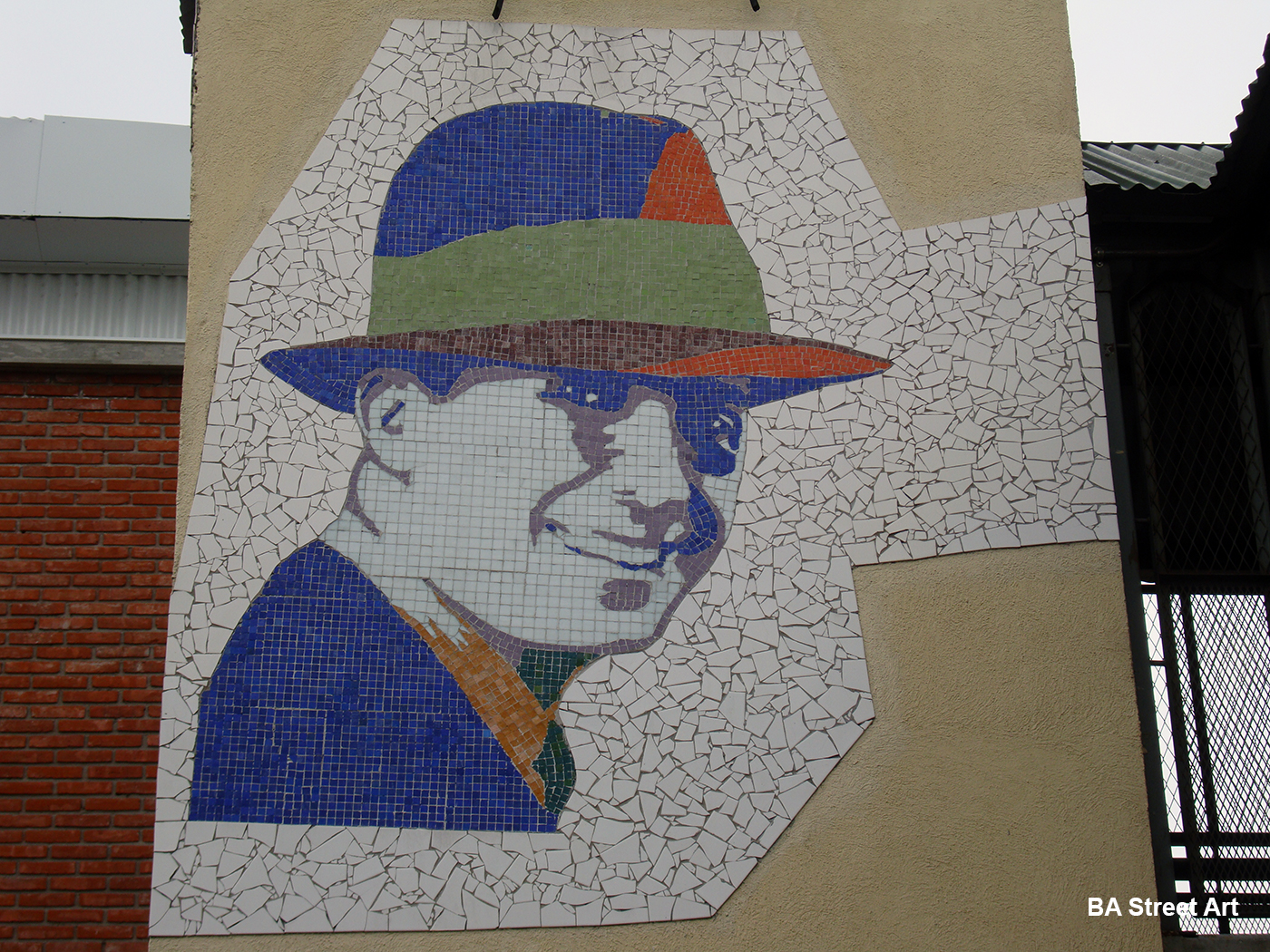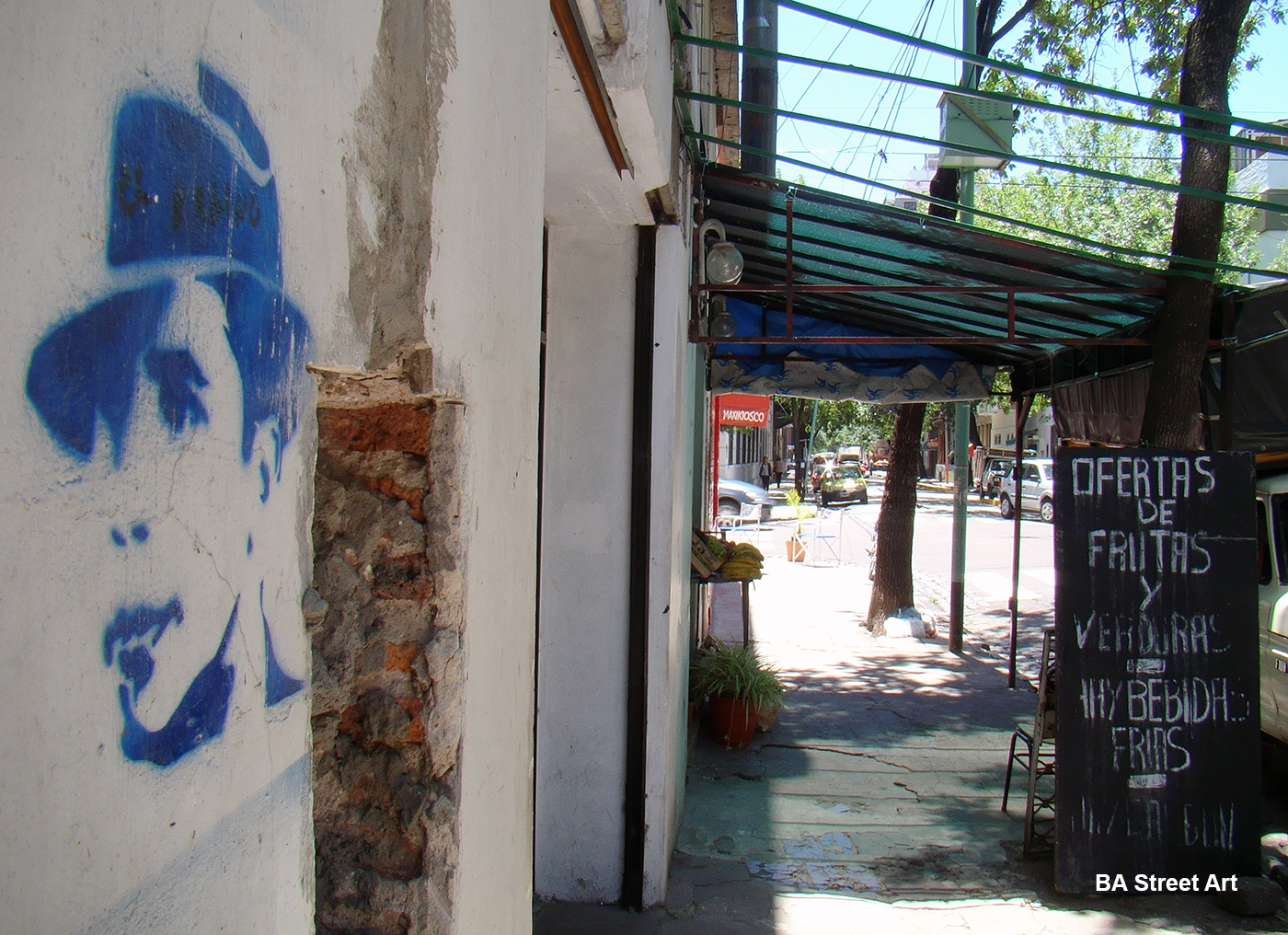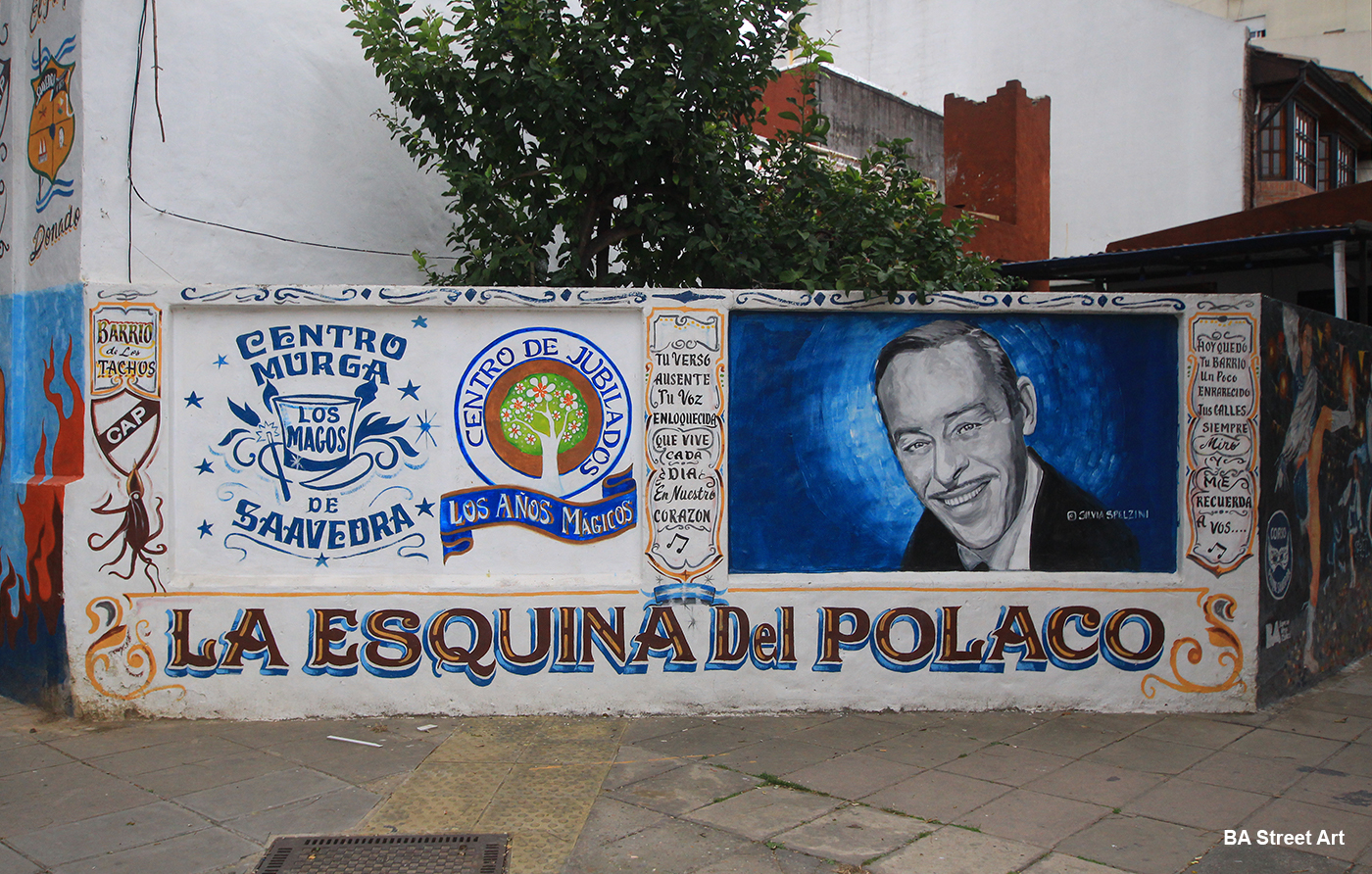Buenos Aires is famous for being the tango capital of the world and its streets are also decorated with murals and artworks relating to the latin dance. Photos by Buenos Aires Street Art.
Such is the popularity of tango that it has become one of the biggest tourist attractions in Buenos Aires. The Argentine capital hosts the Tango World Championships in August / September each year drawing around half a million visitors to its events held at different venues around the city. It’s estimated that there are 140 milongas (tango dance halls) in Buenos Aires and there are radio stations dedicated just to tango music. No surprise then that there are plenty of tango-themed murals and street art around the city depicting musicians, singers and composers who form a part of tango folklore.
Marino Santa Maria
Local artist Marino Santa Maria is famous for his murals featuring Argentine tango legend Carlos Gardel with his infamous trilby hat. Many of Marino’s murals and artworks on mosaic tiles (or azulejos) can be found in the Abasto neighbourhood close to the house at Jean Jaures 735, now a museum, where Gardel used to live with his mother from 1927 to 1933.
In an interview with Marino Santa Maria, he told Buenos Aires Street Art about his admiration for Gardel who he described as “Latin America’s first popstar”.
Marino has painted numerous portraits of Gardel around the neighbourhood of Abasto.
Marino has also created a series of murals of Gardel using azulejos or mosaic tiles.
Carlos Paez Vilaró
Uruguayan artist Carlos Páez Vilaró was invited by the city government to paint a series of murals in Buenos Aires in 1989. His best-known mural is called ‘Mi Buenos Aires Querido’ (‘My Dear Buenos Aires’) named after the famous tango by Gardel. The mural looms large over the busy Avenue Figueroa Alcorta close to MALBA museum and next to one the city’s most exclusive districts Barrio Parque that is home to the rich and famous including chat show queens Susana Giménez and Mirtha Legrand.
More than a 130 years have passed since Gardel was born but his birthplace and nationality are still hot topics of debate between Uruguayans and Argentines alike. One official biography claims he was born in Toulouse, France in December 1890, before moving to Argentina in 1893. Another says Gardel’s passport was found after he died in an airplane crash on 24 June 24 1935 in Medellin, stating that he was born in Tacuarembó, a small village in the north of Uruguay in 1887. Whatever is true, it seems certain he spent much of his childhood living in the neighbourhood of Abasto in Buenos Aires.
Páez Vilaró was one of Uruguay’s best-loved artists. He built his house, studio and gallery named Casa Pueblo in Punta Ballena around 13km from Punta del Este on a cliff’s edge with dramatic views overlooking the South Atlantic. Páez Vilaró was in contact with artists such as Pablo Picasso, Salvador Dalí, Andy Warhol, Giorgio De Chirico and Alexander Calder.
Alfredo Segatori
Argentine muralist Alfredo Segatori is one of the city best-known street artists and was famous for painting the biggest mural in the world painted by one single artist. And he has painted a series of tango murals close to the Hippodrome in Palermo. One mural features a milonga (tango ballroom) with couples and singletons sitting around the dance floor.

Couple embrace as they dance tango in a mural by Alfredo Segatori in Palermo (photo © BA Street Art)
Another section of the mural depicts an elderly couple locked in embrace. It refers to 2×4 – that is the rhythm of the milonga.
On the other side of the avenue close to the Hippodrome, the city’s horse-racing track and paddock, is a beaming portrait of Gardel flanked by Irineo Leguisamo riding Lunático. Gardel was a close friend of the champion jockey who won the two most prestigious races in Argentina – the Carlos Pellegrini Gran Prix and the Jockey Club Grand Prix – on 10 and seven occasions respectively.

New version of Carlos Gardel & Lunatico painted by Alfredo Segatori in Palermo (photo © BA Street Art)
Alfredo painted a new portrait of Gardel and Lunatico in 2023 as part of his project ‘Exabrupto de Color’ or ‘Burp of Colour’ that features his abstract art with splashes or ‘burps’ of colour painted with an airbrush.

Mural of Messi in tango dress painted by Segatori (photo © BA Street Art)
In 2024, Segatori also created a cool portrait of Argentine football legend Lionel Messi in tango guise with a Gardel-style trilby hat and scarf. Check out our blog post about Messi murals in Buenos Aires

Tango stencil by Jef Aerosol at Centro Cultural Recoleta (right) and Tango-themed mural in Palermo (photo © BA Street Art)
French stencil artist Jef Aerosol visited Buenos Aires in 2013 and painted a series of stencils for an exhibition at Centro Cultural Recoleta including this one above of a tango couple. Check out our story about Jef Aerosol in Buenos Aires
Chacarita
Different neighbourhoods around the city are also associated with tango. Gardel was laid to rest in Chacarita Cemetery and his tomb can be found to the far left of the main entrance. Several Argentine tango greats such as Aníbal Troilo, Osvaldo Pugliese and Roberto Goyeneche have also had their ashes interred there, along with music legends such as Gustavo Cerati and Norberto ‘Pappo’ Napolitano.
Argentine stencil artist Cabaio Spirito has painted a huge artwork depicting Gardel on one wall of the cemetery.
A mural of the tango legend Gardel was also painted on the front entrance of Centro Cultural Carlos Gardel in Chacarita.
San Cristóbal
Stencil of Gardel in the neighbourhood of San Cristóbal.
Almagro
Almagro is another neighbourhood associated with tango. This VW camper van belonging to Sonata Bar is painted with a portrait of Gardel and Troilo with a tango theme.
San Telmo

Tango mural in San Telmo painted in 1993 by Munu Actis Goretta, Irene Luparia, Rafael Landea & Raúl Ruiz Leguizamón (photo © BA Street Art)
San Telmo is Buenos Aires’ oldest barrio where there are numerous venues offering tango shows. Across Avenida Independencia from El Viejo Almacén, where Aníbal Troilo, Roberto Goyeneche and Osvaldo Pugliese all performed, is a huge tango-themed mural painted by artists Munu Actis Goretta, Irene Luparia, Rafael Landea and Raúl Ruiz Leguizamón.
La Boca
With its many souvenir shops and stalls selling artworks along El Caminito and near La Bombonera, there is no shortage of tango-themed art decorating store fronts and walls in La Boca.
Saavedra
Roberto Goyeneche
Argentine tango singer Roberto Goyeneche was regarded as having one of the best voices in tango porteño. He was nicknamed El Polaco (The Pole) due to his blond hair and lived and died in the neighbourhood of Saavedra. Goyeneche used to sing in the nearby social club named El Tabaño that has a plaque and photographs on the walls dedicated to him.
Goyeneche used to live on the corner of Avenida Del Tejar (now Av Ricardo Balbín) and Superí and the street corner in Saavedra is named ‘La Esquina del Polaco’ after him.
Anibal Troilo
Aníbal Troilo nicknamed ‘Pichuco’ was an Argentine tango musician and composer known for playing the bandoneon. Murals of him are located in many different barrios.
The biggest tango-themed mural in La Boca is the mural painted by Peruvian artist Mario Abad featuring musician and composer Anibal Troilo playing the bandoneon and Argentine actress Tita Merello. It also includes filetado-style decoration painted with neon spray paint. Check out our blog post about it here
Osvaldo Pugilese

Pugilese (left) with Goyeneche mural by Causi on shutters of a pizzeria in San Telmo (photo © BA Street Art)
Osvaldo Pugliese was another great representative of Argentine tango whose music was marked by a strong rhythm and intense emotion. Pugliese was born in the neighbourhood of Villa Crespo where a corner is named after him and his orchestra and he continued to perform until his death aged 89 in 1995.

Statue of Pugliese & figures of him & his orchestra on Avenida Corrientes, Villa Crespo (photo © BA Street Art)
Astor Piazzolla

Stencil of Astor Piazzolla in Parque Patricios (photo © BA Street Art)
Astor Piazzolla is another tango legend who was famous for his skills with the bandoneon as well as being a composer and performer. Piazzolla is also credited with helping revolutionise and modernise the tango creating a new style called ‘nuevo tango’.

Mural in city centre that is similar in style to Emilio Pettoruti’s ‘painting Quinteto’ (1927) (photo © BA Street Art)
All photos © Buenos Aires Street Art





























